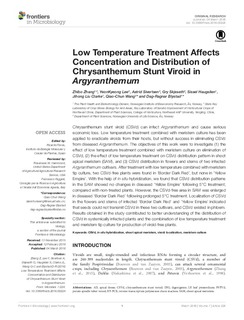| dc.contributor.author | Zhang, Zhibo | |
| dc.contributor.author | Lee, YeonKyeong | |
| dc.contributor.author | Sivertsen, Astrid | |
| dc.contributor.author | Skjeseth, Gry | |
| dc.contributor.author | Haugslien, Sissel | |
| dc.contributor.author | Clarke, Jihong | |
| dc.contributor.author | Wang, Qiaochun* | |
| dc.contributor.author | Blystad, Dag-Ragnar | |
| dc.date.accessioned | 2016-09-06T09:45:55Z | |
| dc.date.accessioned | 2018-05-29T11:43:34Z | |
| dc.date.available | 2016-09-06T09:45:55Z | |
| dc.date.available | 2018-05-29T11:43:34Z | |
| dc.date.issued | 2016 | |
| dc.identifier.citation | Zhang, Z., Lee, Y., Sivertsen, A., Skjeseth, G., Haugslien, S., Clarke, J. L., ... & Blystad, D. R. (2016). Low Temperature Treatment Affects Concentration and Distribution of Chrysanthemum Stunt Viroid in Argyranthemum. Frontiers in microbiology, 7, 224. | nb_NO |
| dc.identifier.issn | 1664-302X | |
| dc.identifier.uri | http://hdl.handle.net/11250/2499584 | |
| dc.description.abstract | Chrysanthemum stunt viroid (CSVd) can infect Argyranthemum and cause serious economic loss. Low temperature treatment combined with meristem culture has been applied to eradicate viroids from their hosts, but without success in eliminating CSVd from diseased Argyranthemum. The objectives of this work were to investigate (1) the effect of low temperature treatment combined with meristem culture on elimination of CSVd, (2) the effect of low temperature treatment on CSVd distribution pattern in shoot apical meristem (SAM), and (3) CSVd distribution in flowers and stems of two infected Argyranthemum cultivars. After treatment with low temperature combined with meristem tip culture, two CSVd-free plants were found in ‘Border Dark Red’, but none in ‘Yellow Empire’. With the help of in situ hybridization, we found that CSVd distribution patterns in the SAM showed no changes in diseased ‘Yellow Empire’ following 5°C treatment, compared with non-treated plants. However, the CSVd-free area in SAM was enlarged in diseased ‘Border Dark Red’ following prolonged 5°C treatment. Localization of CSVd in the flowers and stems of infected ‘Border Dark Red’ and ‘Yellow Empire’ indicated that seeds could not transmit CSVd in these two cultivars, and CSVd existed in phloem. Results obtained in the study contributed to better understanding of the distribution of CSVd in systemically infected plants and the combination of low temperature treatment and meristem tip culture for production of viroid-free plants. | nb_NO |
| dc.language.iso | eng | nb_NO |
| dc.rights | Navngivelse 4.0 Internasjonal | * |
| dc.rights.uri | http://creativecommons.org/licenses/by/4.0/deed.no | * |
| dc.title | Low temperature treatment affects concentration and distribution of Chrysanthemum stunt viroid in Argyranthemum | nb_NO |
| dc.type | Journal article | nb_NO |
| dc.type | Peer reviewed | nb_NO |
| dc.date.updated | 2016-09-06T09:45:55Z | |
| dc.description.version | publishedVersion | nb_NO |
| dc.rights.holder | © 2016 Zhang, Lee, Sivertsen, Skjeseth, Haugslien, Clarke, Wang and Blystad. This is an open-access article distributed under the terms of the Creative Commons Attribution License (CC BY). The use, distribution or reproduction in other forums is permitted, provided the original author(s) or licensor are credited and that the original publication in this journal is cited, in accordance with accepted academic practice. No use, distribution or reproduction is permitted which does not comply with these terms. | nb_NO |
| dc.source.pagenumber | 8 | nb_NO |
| dc.source.volume | 7 | nb_NO |
| dc.source.journal | Frontiers in microbiology | nb_NO |
| dc.identifier.doi | 10.3389/fmicb.2016.00224 | |
| dc.identifier.cristin | 1364247 | |

